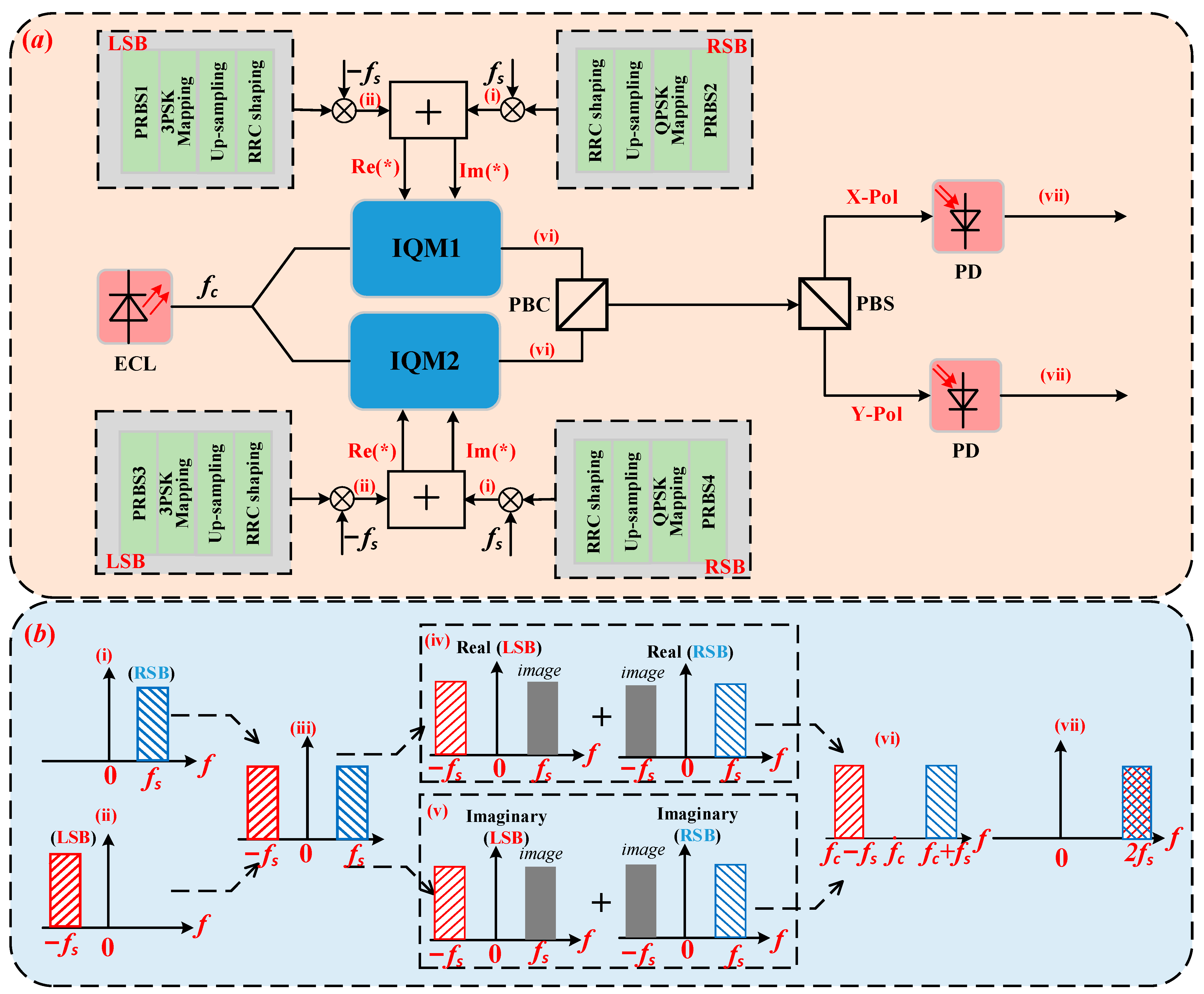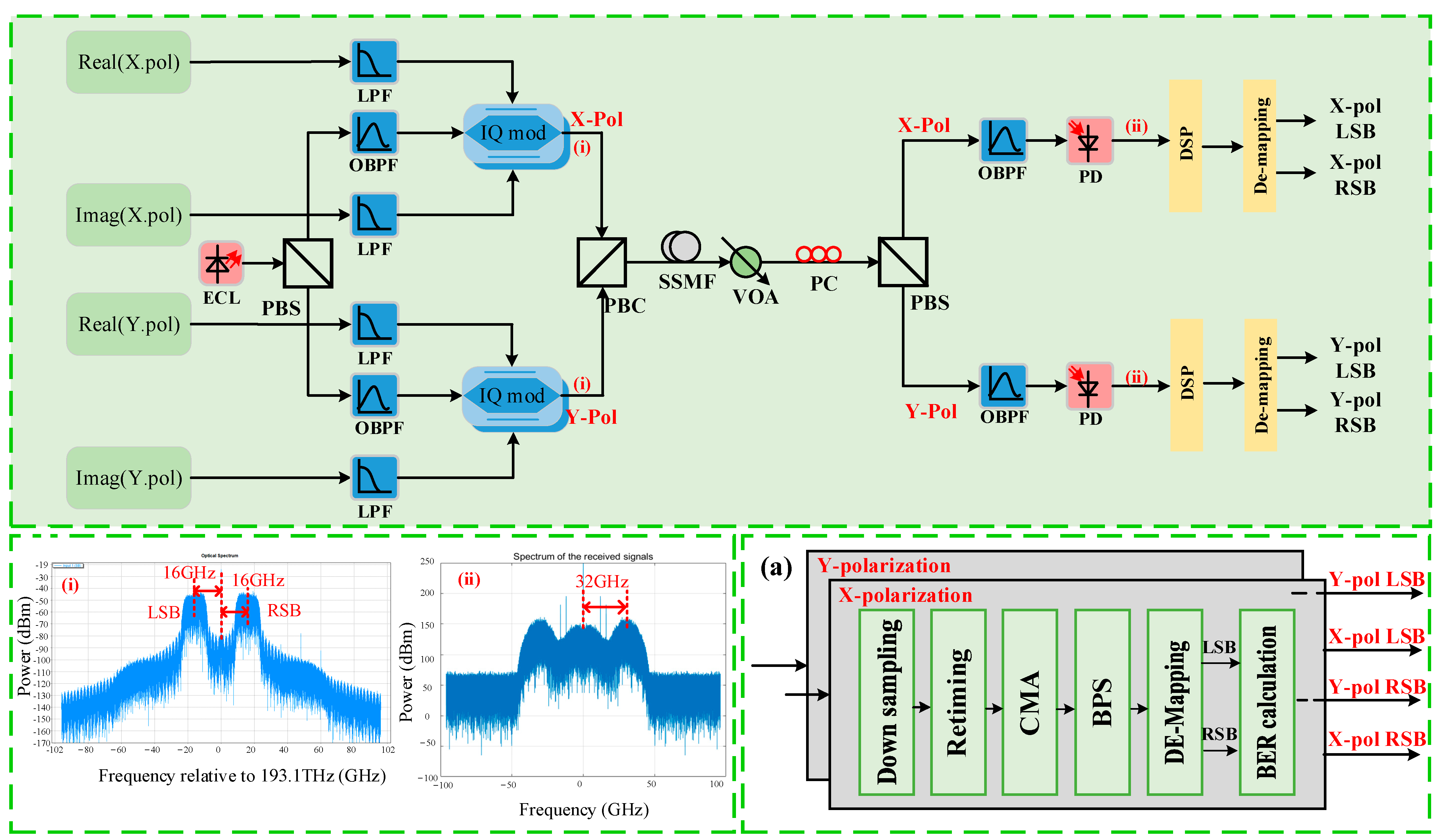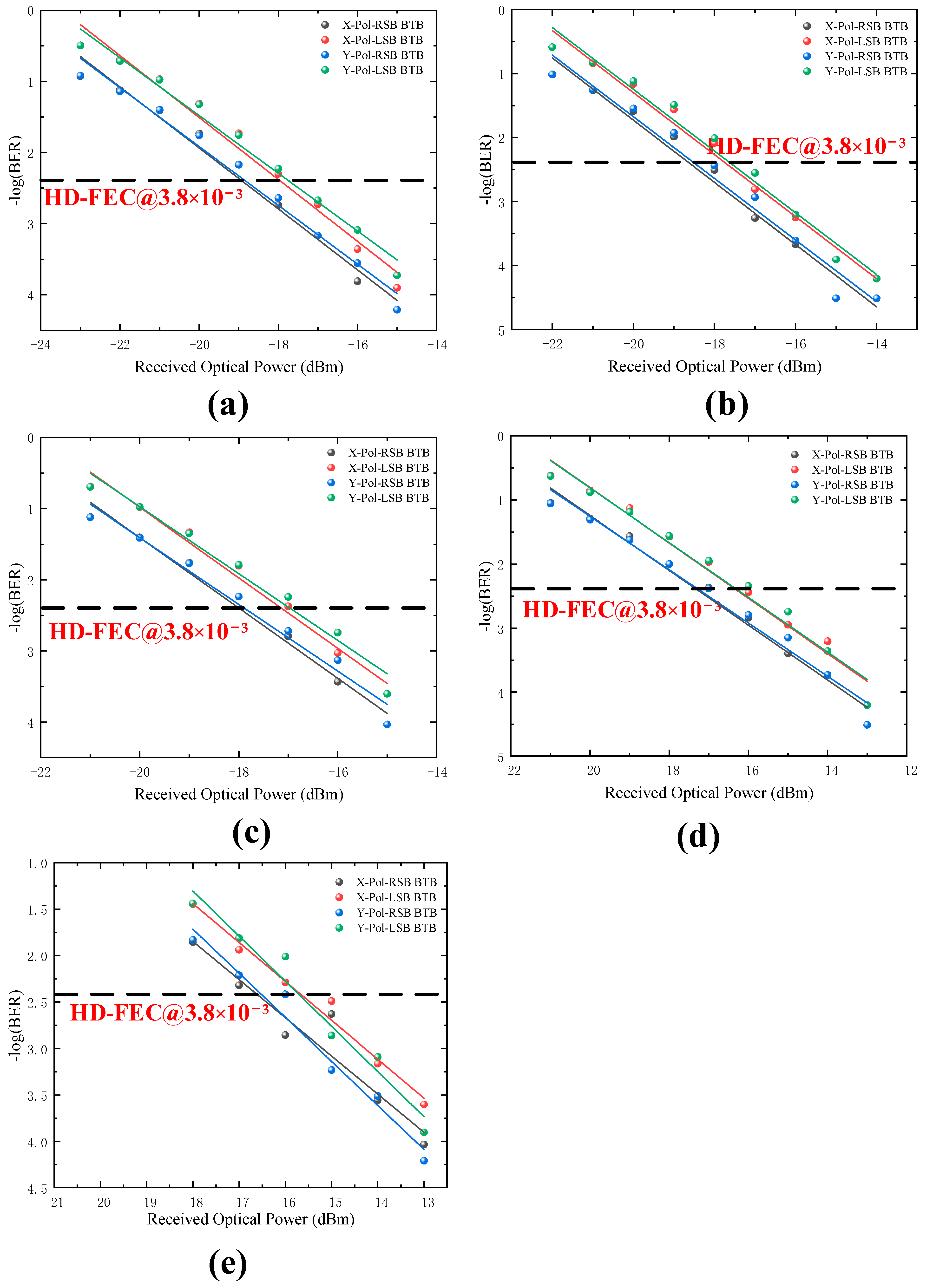Optical Polarization Division Multiplexing Transmission System Based on Simplified Twin-SSB Modulation
Abstract
1. Introduction
2. Principle
2.1. Principle of Twin-SSB Signal Generation
2.2. Principle of Twin-SSB Signal Detection Based on a Single PD
3. Simulation Settings and Results
3.1. Simulation Settings
3.2. Results
4. Conclusions
Author Contributions
Funding
Institutional Review Board Statement
Informed Consent Statement
Data Availability Statement
Acknowledgments
Conflicts of Interest
References
- Takano, K.; Naganuma, Y.; Nakagawa, K. Performance analysis of optical single sideband modulation based on Mach-Zehnder interferometers and its dispersive fiber transmission. IEICE Trans. Commun. 2005, 88, 1994–2003. [Google Scholar] [CrossRef]
- Sampath, K.I.A.; Takano, K. PAPR reduction technique for optical SSB modulation using peak folding. In Proceedings of the 2015 Opto-Electronics and Communications Conference (OECC), Shanghai, China, 28 June–2 July 2015; pp. 1–5. [Google Scholar]
- Sampath, K.I.A.; Takano, K.; Sato, M. Self-phase Modulation Based Signal Distortions of Optical SSB-SC Signal with Pilot Carrier. In Proceedings of the 2016 21st OptoElectronics and Communications Conference (OECC) held jointly with 2016 International Conference on Photonics in Switching (PS), Niigata, Japan, 3–7 July 2016. [Google Scholar]
- Li, X.; Xu, Y.; Yu, J. Single-sideband W-band photonic vector millimeter-wave signal generation by one single I/Q modulator. Opt. Lett. 2016, 41, 4162–4165. [Google Scholar] [CrossRef]
- Li, X.; Xiao, J.; Yu, J. Long-distance wireless mm-wave signal delivery at W-band. J. Lightw. Technol. 2016, 34, 661–668. [Google Scholar] [CrossRef]
- Wang, Y.; Yu, J.; Chi, N. Experimental Demonstration of 120-Gb/s Nyquist PAM8-SCFDE for Short-Reach Optical Communication. IEEE Photon. J. 2015, 7, 1–5. [Google Scholar] [CrossRef]
- Chen, X.; Antonelli, C.; Mecozzi, A. High-capacity direct-detection systems. In Optical Fiber Telecommunications VII; Academic Press: Cambridge, MA, USA, 2020; pp. 419–441. [Google Scholar]
- Zhang, L.; Zuo, T.; Mao, Y. Beyond 100-Gb/s transmission over 80-km SMF using direct-detection SSB-DMT at C-band. J. Lightw. Technol. 2016, 34, 723–729. [Google Scholar] [CrossRef]
- Zhang, X.; Zhang, C.; Chen, C. Non-optical carrier SSB-OFDM PONs with the improved receiver sensitivity and potential transmission nonlinearity tolerance. IEEE Photon. J. 2017, 9, 1–10. [Google Scholar] [CrossRef]
- Zhang, X.; Zhang, C.; Chen, C. All-optical VPN utilizing DSP-based digital orthogonal filters access for PONs. Opt. Commun. 2018, 413, 347–352. [Google Scholar] [CrossRef]
- Fan, S.; Zhuge, Q.; Sowailem, M.Y.S. Twin-SSB Direct Detection Transmission over 80 km SSMF Using Kramers-Kronig Receiver. In Proceedings of the 2017 European Conference on Optical Communication (ECOC), Gothenburg, Sweden, 17–21 September 2017. [Google Scholar]
- Lyons, W. SSB/ISB systems for long-distance radiotelegraphy. Electr. Eng. 1960, 79, 146–149. [Google Scholar] [CrossRef]
- Chen, M.; Peng, M.; Zhou, H. Receiver sensitivity improvement in spectrally-efficient guard-band Twin-SSB-OFDM using an optical IQ modulator. Opt. Commun. 2017, 405, 259–264. [Google Scholar] [CrossRef]
- Kashiwagi, S.; Nakamura, R.; Nakamura, M. Novel Twin-SSB-SC method using a DP-QPSK modulator. In Proceedings of the 2017 Opto-Electronics and Communications Conference (OECC) and Photonics Global Conference (PGC), Singapore, 31 July–4 August 2017; pp. 3–10. [Google Scholar]
- Fan, S.; Li, Y.; Xing, Z. Comparison of Kramer-Kronig receiver and one-stage SSBI mitigation algorithm in Twin-SSB direct detection transmission systems enabled by MIMO processing. Opt. Commun. 2019, 434, 75–79. [Google Scholar] [CrossRef]
- Zhu, Y.; Ruan, X.; Zou, K. Beyond 200G direct detection transmission with Nyquist asymmetric Twin-SSB signal at C-band. J. Lightw. Technol. 2017, 35, 3629–3636. [Google Scholar] [CrossRef]
- Chien, H.C.; Jia, Z.; Zhang, J. Optical independent sideband modulation for bandwidth-economic coherent transmission. Opt. Express 2014, 2, 9465–9470. [Google Scholar] [CrossRef]
- Wang, Y.; Yu, J.; Chien, H.C. Transmission and Direct Detection of 300-Gbps DFT-S OFDM Signals Based on O-ISB Modulation with Joint Image-cancellation and Nonlinearity-mitigation. In Proceedings of the 42nd European Conference on Optical Communication, Dusseldorf, Germany, 18–22 September 2016; pp. 1–3. [Google Scholar]
- Dong, Z.; Chien, H.C.; Yu, J. Very- high-throughput coherent ultra-dense WDM-PON based on Nyquist-ISB modulation. IEEE Photon. Technol. Lett. 2015, 27, 763–766. [Google Scholar] [CrossRef]
- Zhang, L.; Zuo, T.; Zhang, Q.; Zhou, J.; Liu, G.N. Single wavelength 248-Gb/s transmission over 80-km SMF based on Twin-SSB- DMT and direct detection. Opt. Commun. Conf. 2016, 133–135. [Google Scholar]
- Zhang, L.; Zuo, T.; Zhang, Q. 150-Gb/s DMT over 80-km SMF transmission based on spectrally efficient SSBI cancellation using guard-band Twin-SSB technique. In Proceedings of the ECOC 2016 42nd European Conference on Optical Communication, Dusseldorf, Germany, 18–22 September 2016; pp. 1178–1180. [Google Scholar]
- Zhu, Y.; Wang, P.; Jiang, M. 4×288Gb/s Orthogonal Offset Carriers Assisted PDM Twin-SSB WDM Transmission with Direct Detection. In Proceedings of the 2019 Optical Fiber Communications Conference and Exhibition (OFC), San Diego, CA, USA, 3–7 March 2019. [Google Scholar]
- Yam, Y.O.; Wong, K.H. An innovative AM broadcasting system for voice and data information. In Proceedings of the Proceedings of 1997 Asia-Pacific Microwave Conference, Hong Kong, China, 2–5 December 1997; pp. 1121–1124. [Google Scholar]
- Zhu, M.; Zhang, L.; Wang, J. Radio-Over-Fiber Access Architecture for Integrated Broadband Wireless Services. J. Lightwave Technol. 2013, 31, 3614–3620. [Google Scholar] [CrossRef]
- Zhang, L.; Zuo, T.; Zhang, Q. Transmission of 112-Gb/s + DMT over 80-km SMF enabled by Twin-SSB technique at 1550 nm. In Proceedings of the 2015 European Conference on Optical Communication (ECOC), Valencia, Spain, 27 September–1 October 2015; pp. 1–3. [Google Scholar]
- Li, X.; Yu, J. 2×2 multiple-input multiple-output optical–wireless integration system based on optical independent-sideband modulation enabled by an in-phase/quadrature modulator. Opt. Lett. 2016, 41, 3138–3141. [Google Scholar] [CrossRef]
- Chen, X.; Yao, J. Wavelength Reuse in an RoF Link Based on CS-DSB, Coherent Detection and DSP. IEEE Photon. Technol. Lett. 2017, 29, 975–978. [Google Scholar] [CrossRef]
- Chen, X.; Dong, P.; Chandrasekhar, S. Characterization and Digital Pre-compensation of Electro-optic Crosstalk in Silicon Photonics I/Q Modulators. In Proceedings of the 42nd European Conference on Optical Communication, Dusseldorf, Germany, 18–22 September 2016. [Google Scholar]
- Khan, Z.A.; Zenteno, E.; Händel, P. Digital Predistortion for Joint Mitigation of I/Q Imbalance and MIMO Power Amplifier Distortion. IEEE Trans. Microw. 2017, 65, 322–333. [Google Scholar] [CrossRef]
- Pan, X.; Zhang, B.; Liu, X. Mitigation of crosstalk between RSB and LSB signals generated by one I/Q modulator. Opt. Express 2020, 28, 2238–2250. [Google Scholar] [CrossRef]
- Petit, M.; Springer, A. Analysis of a Properness-Based Blind Adaptive I/Q Filter Mismatch Compensation. IEEE Trans. Wireless Commun. 2016, 15, 781–793. [Google Scholar] [CrossRef]
- Xiao, J.; Yu, J.; Li, X. 40-Gb/s PDM-QPSK signal transmission over 160-m wireless distance at W-band. Opt. Lett. 2015, 40, 998–1001. [Google Scholar] [CrossRef]
- Li, X.; Yu, J.; Xiao, J. Fiber-wireless-fiber link for 128-Gb/s PDM-16QAM signal transmission at W-band. IEEE Photonics Technol. Lett. 2014, 26, 1948–1951. [Google Scholar] [CrossRef]
- Li, F.; Cao, Z.; Li, X. Fiber-wireless transmission system of PDM-MIMO-OFDM at 100 GHz frequency. J. Lightwave Technol. 2013, 31, 2394–2399. [Google Scholar] [CrossRef]
- Zhang, J.; Yu, J.; Jia, Z. 400 G Transmission of Super-Nyquist-Filtered Signal Based on Single-Carrier 110-GBaud PDM QPSK with 100-GHz Grid. J. Lightwave Technol. 2014, 32, 3239–3246. [Google Scholar] [CrossRef]
- Wang, W.; Zou, D.; Feng, X. Optical polarization division multiplexing fiber-wireless integration system at Ka-band based on a low-cost dual-drive MZM. Opt. Express 2021, 29, 37453–37463. [Google Scholar] [CrossRef]





Publisher’s Note: MDPI stays neutral with regard to jurisdictional claims in published maps and institutional affiliations. |
© 2022 by the authors. Licensee MDPI, Basel, Switzerland. This article is an open access article distributed under the terms and conditions of the Creative Commons Attribution (CC BY) license (https://creativecommons.org/licenses/by/4.0/).
Share and Cite
Zhou, Y.; Ming, J.; Wang, L.; Wu, D.; Zhao, L.; Xiao, J. Optical Polarization Division Multiplexing Transmission System Based on Simplified Twin-SSB Modulation. Sensors 2022, 22, 7700. https://doi.org/10.3390/s22207700
Zhou Y, Ming J, Wang L, Wu D, Zhao L, Xiao J. Optical Polarization Division Multiplexing Transmission System Based on Simplified Twin-SSB Modulation. Sensors. 2022; 22(20):7700. https://doi.org/10.3390/s22207700
Chicago/Turabian StyleZhou, Ye, Jun Ming, Leilei Wang, Dongyan Wu, Li Zhao, and Jiangnan Xiao. 2022. "Optical Polarization Division Multiplexing Transmission System Based on Simplified Twin-SSB Modulation" Sensors 22, no. 20: 7700. https://doi.org/10.3390/s22207700
APA StyleZhou, Y., Ming, J., Wang, L., Wu, D., Zhao, L., & Xiao, J. (2022). Optical Polarization Division Multiplexing Transmission System Based on Simplified Twin-SSB Modulation. Sensors, 22(20), 7700. https://doi.org/10.3390/s22207700






